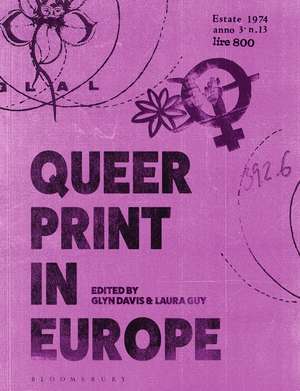Queer Print in Europe
Editat de Glyn Davis, Laura Guyen Limba Engleză Paperback – 16 noi 2022
| Toate formatele și edițiile | Preț | Express |
|---|---|---|
| Paperback (1) | 180.27 lei 3-5 săpt. | +43.51 lei 4-10 zile |
| Bloomsbury Publishing – 16 noi 2022 | 180.27 lei 3-5 săpt. | +43.51 lei 4-10 zile |
| Hardback (1) | 506.08 lei 3-5 săpt. | |
| Bloomsbury Publishing – 16 noi 2022 | 506.08 lei 3-5 săpt. |
Preț: 180.27 lei
Preț vechi: 190.91 lei
-6% Nou
Puncte Express: 270
Preț estimativ în valută:
34.51€ • 37.49$ • 29.00£
34.51€ • 37.49$ • 29.00£
Carte disponibilă
Livrare economică 31 martie-14 aprilie
Livrare express 14-20 martie pentru 53.50 lei
Preluare comenzi: 021 569.72.76
Specificații
ISBN-13: 9781350273498
ISBN-10: 135027349X
Pagini: 272
Ilustrații: 100 colour illus
Dimensiuni: 189 x 246 x 23 mm
Greutate: 0.75 kg
Editura: Bloomsbury Publishing
Colecția Bloomsbury Visual Arts
Locul publicării:London, United Kingdom
ISBN-10: 135027349X
Pagini: 272
Ilustrații: 100 colour illus
Dimensiuni: 189 x 246 x 23 mm
Greutate: 0.75 kg
Editura: Bloomsbury Publishing
Colecția Bloomsbury Visual Arts
Locul publicării:London, United Kingdom
Caracteristici
Includes around 150 full colour illustrations and photographs, alongside recently unearthed archival material and material from the personal collections of those responsible for making and circulating queer print
Notă biografică
Glyn Davis is Professor of Film Studies at the University of St Andrews, UK. He is the author, co-author, or co-editor of eleven books, including The Richard Dyer Reader (BFI/Bloomsbury, co-edited with Jaap Kooijman, forthcoming 2022), The Living End: A Queer Film Classic (forthcoming, 2022), and Pop Cinema (co-edited with Tom Day, forthcoming 2022). From 2016 to 2019, Glyn was the Project Leader of 'Cruising the Seventies: Unearthing Pre-HIV/AIDS Queer Sexual Cultures', a pan-European queer history project funded by HERA and the European Commission (www.crusev.ed.ac.uk).Laura Guy is Lecturer in Fine Art Critical Studies at The Glasgow School of Art, UK. Her research focuses on post-1960s photographic, documentary and print cultures and has recently been published in Third Text, Women: A Cultural Review, Aperture and Frieze. She is editor of Phyllis Christopher, Dark Room: San Francisco Sex and Protest, 1988-2003 (2021).
Cuprins
Introduction, Glyn Davis (University of St Andrews, UK) and Laura Guy (Glasgow School of Art, UK)Part One: Politics of Community Building1. Silent Voices: The 'Arabs' and Gay Liberation in France, Antoine Idier (ESAM, France)2. 'Happiness was in the Pages of this Monthly': The Birth of the Lesbian Press in France and the Fabric of a Space of One's Own (1976-1990), Ilana Eloit (University of Geneva, Switzerland)3. Seeking Acceptance or Revolution? An Overview of the First Italian LGBTQ Magazines, 1971-1979, Dario Pasquini (Independent Researcher, Italy)4. Change Always has to Build: In Conversation with Gail Lewis, Taylor Le Melle (Independent Researcher, the Netherlands) Part Two: Materials and Making5. The Sexual Revolt in Spain in the 1970s through its Publications: Ideas, Fears and Aesthetics, Alberto Berzosa (Carlos III University of Madrid, Spain) and Gracia Trujillo (Complutense University of Madrid, Spain)6. Sexual Difference and Queer Subjectivity in Slovak LGBTQ Print Periodicals, Viera Lorencova (Fitchburg State University, USA)7. Revolt Press, Internationalization and the Development of Gay Markets in Sweden before HIV/AIDS, Thomas Cubbin (University of Gothenburg, Sweden)8. Mietje: In Conversation with Gert Hekma and Mattias Duyves, Benny Nemer (Royal Academy of Fine Arts (KASK), Belgium)Part Three: Generational Interactions 9. This Too is Polish Culture: In Conversation with Karol Radziszewski, Aleksandra Gajowy (Independent Researcher, UK)10. Queer Memory in (re)Constituting and Forgetting the Trans '70s in the UK, Nat Raha (University of St Andrews, UK)11. Encapsulated Time: Generational and Cultural Discrepancies in West German Lesbian Magazines of the 1970s, Janin Afken (Humboldt University, Germany)12. Lavender Menace Revisited: In Conversation with Sigrid Nielsen, Bob Orr and James Ley, Fiona Anderson (Newcastle University, UK)
Recenzii
Queer Print in Europe presents a timely and necessary analysis of queer printmaking, zines and print culture. It is unique in its use of interviews, its wide-ranging historical and political analysis and its challenge to a rights-based historical teleology common in North American analyses of LGBTQ+ cultural phenomenon.
This book represents a vital contribution to the fields of queer history and queer print cultures. It starts from the insistence that queer community relies on the networked circulation of objects, information and ideas. From there, the various chapters explore a range of publications, each exploring how the circulation of printed material since the 1970s has shaped European LGBTQ activism. The collection offers a rich history of European queer print cultures and provides methodologies for future research in the field.
Davis and Guy provide a well-organized and thoughtfully selected collection of essays that represent an exciting broadening of the field of queer print culture from its often US-centered perspective. Exploring themes of inclusion/exclusion, connection/debate, past/present, this book offers both scholars and those interested in queer culture an enticing entry into queer worldmaking. In bringing different voices together and exploring a variety of publications, Queer Print in Europe does exactly what these circulated objects did-foster connection and invite further collaboration.
This book represents a vital contribution to the fields of queer history and queer print cultures. It starts from the insistence that queer community relies on the networked circulation of objects, information and ideas. From there, the various chapters explore a range of publications, each exploring how the circulation of printed material since the 1970s has shaped European LGBTQ activism. The collection offers a rich history of European queer print cultures and provides methodologies for future research in the field.
Davis and Guy provide a well-organized and thoughtfully selected collection of essays that represent an exciting broadening of the field of queer print culture from its often US-centered perspective. Exploring themes of inclusion/exclusion, connection/debate, past/present, this book offers both scholars and those interested in queer culture an enticing entry into queer worldmaking. In bringing different voices together and exploring a variety of publications, Queer Print in Europe does exactly what these circulated objects did-foster connection and invite further collaboration.
